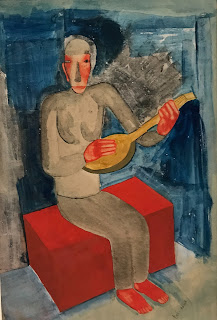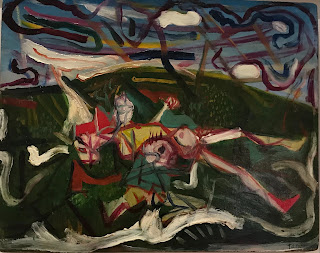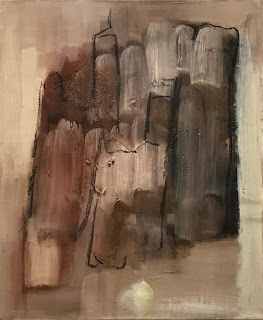WELL KNOWN TO MANY BUT NOT TO ME

A few months ago, I saw this picture in one of my art magazines and found it quite unique. I certainly couldn’t put a name to it. Tal Coat? Who was he?
Then I looked again and saw that the exhibition was on in Aix-en-Provence. Turned the page of the same magazine and saw another picture and the title « Botero - dialogue with Picasso ».
No hesitation this time. I was going to Aix-en-Provence. Years must have flown by since I was there. Once upon a time, my Mother and I would go every year from her summer flat. We would visit cousins and close friends. Those days are far gone as are the people.
I got to my hotel in the middle of the day. Dumped my overnight bag and off I went - in the wrong direction. Is it possible that I could forget a town which I had visited so often? Apparently. Back on track after a good hour of turning in circles only to find that the Granet Museum was a ten minute stroll from the hotel.
Oh dear - a crowd. What were they here for? Then I understood. I saw this.

 |
| A rather empty gallery for someone who is supposed to be well known. |
Cezanne would pull the crowds in. But for Tal Coat? I had the first hour to myself. Pierre Tal-Coat (real name Pierre Louis Jacob; 1905–1985) was a French artist considered to be one of the founders of Tachisme.
Tachisme is a word derived from the French - Spot - perhaps this movement could be compared with abstract expression - an American concept which was developed after the 2nd world war. Something which I have always followed. The abstraction in the Tachisme movement fascinated me.
But getting back to Tal-Coat. One of the « reflections » concerning an artist, really gets me down. « Known all over the world ». Well if he is so well known, why haven’t I seen something about him over all the years I have been following the art world.Especially as he is French. That is not meant to sound pretentious. Also, if he was so well known, why wasn’t there anything translated into English in this huge space of 500 m2 where we were to discover some 180 works?
He had a very different background from many of the artists I know. He was the son of a fisherman in Brittany. When his father died in 1915 (so he was only 10), in 1918 he became a trainee blacksmith. It was then he began to sketch and sculpt! After that there were a line of different activities before he moved to Paris in 1924. He was even a model in one of the art academy and a moulder in a very important centre for us, the Manufacture de Sèvres
The exhibition followed a chronological order. It wasn’t until the later years that we discovered his abstract works. The beginning though was very interesting.
He was inspired by Cezanne. So this was the relationship between the two exhibitions. A little later again he met some well known artists and collectors: Gertrude Stein, André Marchand, Francis Picabia, Ernest Hemingway, Alberto Giacometti, Balthis....just to name a few. He lived for a while in Aix-en-Provence, where I suppose he came into contact with Cezanne's work.
 |
| Gertrude Stein - 1935 |
 |
| Gertrude Stein - 1935 |
 |
| Gertrude Stein - 1935 |
 | |
| Picasso around 1936. (A friend too) |
 |
| Three portraits of Giacometti - 1936 |
 |
| Giacometti - 1935 |
At the beginning of the exhibition, there was this collection of figures and pportraits. Not really realistic and quite strange at that...
 |
| Self Portrait - 1927 |
 |
| Nude and skinned beef (!) - 1926 |
 |
| No Title - 1926 |
 |
| Nude with red stockings - 1934 |
 |
| Mandoline Player - 1927 |
 |
| The Accordenist and Dancers - 1927 |
 |
| Three personnages - 1926 |
 |
| Self Portrait - 1927 |
 |
| Sleeping - 1927 |
 | ||
| Self Portrait - 1941 |
 |
| The Woman with a muff - 1936 |
 |
| Self Portrait - 1937 |
I tI think too that he may have been influenced by his experience during his mimilitary service
 |
| Vanity - 1935 |
 |
| Massacre - 1937 |
 |
| Dogs - 1943 |
 |
| Massacre - 1937 |
 |
| Still Life in a Miror - 1945 |
The break between the realistic work and the abstract was sudden a little disconcerting - were there two artists? From medium size paintings to some which were very powerful in expression and in size.
 |
| Water falling between the rocks - 1949 |
 |
| Someone in a grotto - 1948-49 |
 |
| Rocks - 1950 |
 |
| Transhumance ll - 1959 |
 |
| Iode - 1959 |
 |
| Suspended ll - 1975 |
 |
| Around the Dome -1980 |
 |
| The Wall - 1932 |
 |
| Masks - 1935 |
 |
| Landscape in Aix - 1941 |
 |
| Rain on Sainte-Victoire - 1949 (Cezanne's influence?) |
 |
| No Title - 1948 |
 |
| Aborescence - 1948 |
 |
| Fish - 1948 |
 |
| Cock - 1946 |
 |
| No Title - 1962 |
 |
| Rough and Fluid - 1956 |
 |
| Landscape - 1957 |
 |
| Grand Tracé ll, 1955 |
 |
| Falling éclat - 1972-73 |
 |
| Meeting - 1967-1980 |
 |
| Self Portrait - 1982 |
 |
| Signs in a Red Rock - 1965 |
I looked at my watch - more than two hours had flown by. This exhibition had been quite an experience because of its diversity but before leaving, I decided to have a quick look at the Cezanne. The crowds had thinned. I might be able to see something.



Commentaires